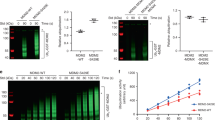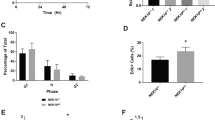Abstract
Levels of the tumour suppressor protein p53 are increased in response to a variety of DNA damaging agents. DNA damage-induced phosphorylation of p53 occurs at serine-15 in vivo. Phosphorylation of p53 at serine-15 leads to a stabilization of the polypeptide by inhibiting its interaction with Mdm2, a protein that targets p53 for ubiquitin-dependent degradation. However, the mechanisms by which DNA damage is signalled to p53 remain unclear. Here, we report the identification of a novel DNA-activated protein kinase that phosphorylates p53 on serine-15. Fractionation of HeLa nuclear extracts and biochemical analyses indicate that this kinase is distinct from the DNA-dependent protein kinase (DNA-PK) and corresponds to the human cell cycle checkpoint protein ATR. Immunoprecipitation studies of recombinant ATR reveal that catalytic activity of this polypeptide is required for DNA-stimulated phosphorylation of p53 on serine-15. These data suggest that ATR may function upstream of p53 in a signal transduction cascade initiated upon DNA damage and provide a biochemical assay system for ATR activity.
This is a preview of subscription content, access via your institution
Access options
Subscribe to this journal
Receive 50 print issues and online access
$259.00 per year
only $5.18 per issue
Buy this article
- Purchase on Springer Link
- Instant access to full article PDF
Prices may be subject to local taxes which are calculated during checkout




Similar content being viewed by others
References
Artuso M, Esteve A, Bresil H, Vuillaume M and Hall J. . 1995 Oncogene 11: 1427–1435.
Banin S, Moyal L, Shieh S-Y, Taya Y, Anderson CW, Chessa L, Smorodinsky NI, Prives C, Reiss Y, Shiloh Y and Ziv Y. . 1998 Science 281: 1674–1677.
Canman CE, Lim D-S, Cimprich KA, Taya Y, Tamai K, Sakaguchi KA, Apella E, Kastan MB and Siliciano JD. . 1998 Science 281: 1677–1679.
Cliby WA, Roberts CJ, Cimprich KA, Stringer CM, Lamb JR, Schreiber SL and Friend SH. . 1998 EMBO J. 17: 159–169.
Dvir A, Stein LY, Calore BL and Dynan WS. . 1993 J. Biol. Chem. 268: 10440–10447.
Elledge SJ. . 1996 Science 274: 1664–1672.
Gately DP, Hittle JC, Chan GK and Yen TJ. . 1998 Mol. Biol. Cell. 9: 2361–2374.
Giaccia AJ and Kastan MB. . 1998 Genes Dev. 12: 2973–2983.
Gottlieb TM and Jackson SP. . 1993 Cell 72: 131–142.
Gottlieb TM and Oren M. . 1997 Biochim. Biophys. Acta 1287: 77–102.
Hartley KO, Gell D, Smith GCM, Zhang H, Divecha N, Connelly MA, Admon A, Lees-Miller SP, Anderson CW and Jackson SP. . 1995 Cell 82: 849–856.
Hoekstra MF. . 1997 Curr. Opin. Genet. Dev. 7: 170–175.
Hupp TR, Meek DM, Midgley CA and Lane DP. . 1992 Cell 71: 875–886.
Jackson SP. . 1996 Cancer Surv. 28: 261–279.
Kastan MB, Zhan Q, El-Deiry WS, Carrier F, Jacks T, Walsh WV, Plunkett BS, Vogelstein B and Fornace AJJ. . 1992 Cell 71: 587–597.
Khanna K and Lavin MF. . 1993 Oncogene 8: 3307–3312.
Ko LJ and Prives C. . 1996 Genes Dev. 10: 1054–1072.
Lakin ND, Weber P, Stankovic T, Rottinghaus ST, Taylor AM and Jackson SP. . 1996 Oncogene 13: 2707–2716.
Levine AJ. . 1997 Cell 88: 323–331.
Longhese MP, Foiani M, Muzi-Falconi M, Lucchini G and Plevani P. . 1998 EMBO J. 17: 5525–5528.
Paulovich AG, Toczyski DP and Hartwell LH. . 1997 Cell 88: 315–321.
Powis G, Bonjouklain R, Berggren MM, Gallegos A, Abraham R, Ashdel C, Zazkow L, Matter WF, Dodge J, Grindley G and Vlamos CJ. . 1994 Cancer Res. 95: 2419–2423.
Prives C. . 1998 Cell 95: 5–8.
Rotman G and Shiloh Y. . 1997 Cancer Surv. 29: 285–304.
Shieh S-Y, Ikeda M, Taya Y and Prives C. . 1997 Cell 91: 325–334.
Siliciano JD, Canman CE, Taya Y, Sakaguchi K, Appella E and Kastan MB. . 1997 Genes Dev. 11: 3471–3481.
Smith GCM and Jackson SP. . 1999 Genes Dev. (in press).
Song Q, Lees-Miller SP, Kumar S, Zhang N, Chan DW, Smith GCM, Jackson SP, Alnemri ES, Litwack G and Lavin MF. . 1996 EMBO J. 15: 3238–3246.
Steegenga WT, van der Eb AJ and Jochemsen AG. . 1996 J. Mol. Biol. 263: 103–113.
Tibbetts RS, Brumbaugh KM, Williams JM, Sarkaria JN, Cilby WA, Shieh SY, Taya Y, Prives C and Abraham RT. . 1999 Genes Dev. 13: 152–157.
Ui M, Okado T, Hazeki K and Hazeki O. . 1995 Trends Biochem. Sci. 20: 303–307.
Weinert I. . 1998 Curr. Opin. Genet. Dev. 8: 185–193.
Woo RA, McLure KG, Lees-Miller SP, Rancourt DE and Lee PWK. . 1998 Nature 394: 700–704.
Wright WA, Keegan KS, Herendeen DR, Bentley NJ, Carr AM, Hoekstra MF and Concannon P. . 1998 Proc. Natl. Acad. Sci. USA 95: 7445–7450.
Acknowledgements
We thank members of the SPJ laboratory for their advice and support. In particular, we thank Graeme Smith, John Rouse, Daniel Durocher and Susan Critchlow for helpful discussions. We also thank David Lane for advice and support. Cell lines expressing ATR derivatives were a generous gift from Stephen Friend, and cyclin A/cdk2 was a gift from Mark Jackman and Jon Pines. This work was funded by grants from the Cancer Research Campaign, the Kay Kendall Leukaemia Fund and the A-T Children's Project.
Author information
Authors and Affiliations
Rights and permissions
About this article
Cite this article
Lakin, N., Hann, B. & Jackson, S. The ataxia-telangiectasia related protein ATR mediates DNA-dependent phosphorylation of p53. Oncogene 18, 3989–3995 (1999). https://doi.org/10.1038/sj.onc.1202973
Received:
Revised:
Accepted:
Published:
Issue Date:
DOI: https://doi.org/10.1038/sj.onc.1202973
Keywords
This article is cited by
-
CRISPR-based kinome-screening revealed MINK1 as a druggable player to rewire 5FU-resistance in OSCC through AKT/MDM2/p53 axis
Oncogene (2022)
-
Therapeutic targeting of ATR in alveolar rhabdomyosarcoma
Nature Communications (2022)
-
Heterochromatic genome instability and neurodegeneration sharing similarities with Alzheimer’s disease in old Bmi1+/− mice
Scientific Reports (2019)
-
Implication of the VRK1 chromatin kinase in the signaling responses to DNA damage: a therapeutic target?
Cellular and Molecular Life Sciences (2018)
-
Elevated APOBEC3B expression drives a kataegic-like mutation signature and replication stress-related therapeutic vulnerabilities in p53-defective cells
British Journal of Cancer (2017)



